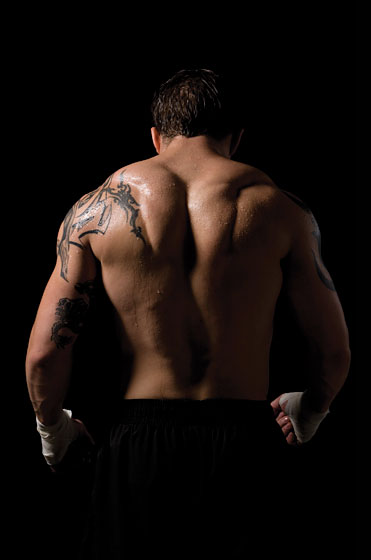Excellent Strategy for Upper Back Development
 I really don't think there's a such thing as "too much upper back work." In fact, I'd go so far to say that undergoing a training plan (be it athletic performance training, running, bodybuilding, etc.) without paying special heed to the portion of your torso that you don't see in the mirror is akin to constructing a house on a foundation of sand.
Keeping it brief, here's a simple, truncated list of what upper back work can do for you:
I really don't think there's a such thing as "too much upper back work." In fact, I'd go so far to say that undergoing a training plan (be it athletic performance training, running, bodybuilding, etc.) without paying special heed to the portion of your torso that you don't see in the mirror is akin to constructing a house on a foundation of sand.
Keeping it brief, here's a simple, truncated list of what upper back work can do for you:
- Improve posture
- Augment your "big lift" training (upper back weakness is often a limiting factor in how much you can deadlift, squat/front squat, and bench press)
- Ward off shoulder issues
- Offset all the slouching we do on a daily basis
And, perhaps what most of the majority of the crowd cares about: Enhancing one's aesthetic. For the ladies in the crowd, nothing exudes more confidence than standing "tall" with the shoulders pulled back. For the men the crowd - with some added assistance from farmers carries - you can at least come close to emulating Tommy Conlon's trap/upper back development which totally PWNED in the movie Warrior (see picture on the left).
Yeah, exactly.
Alright, let's get to it. Here's an awesome strategy to give your upper back some much-needed attention:
Pair a bilateral 'pull' with a unilateral 'push,' and double the number of sets for the pulling exercise.
As soon as I heard this strategy from Eric Cressey I knew it was brilliant, and, upon implementing it in my own training, I wasn't disappointed.
What does it look like?
Pick a bilateral, horizontal pulling exercise (chest-supported row, barbell row, TRX row, cable row, etc.) and pair it with a unilateral pushing exercise (single-arm dumbbell press, single-arm overhead press, single-arm pushup, etc.). I recommend putting this pairing first during an upper body day, so the first two exercises would look something like this:
A1. Seated Cable Row, Pronated Grip
A2. SA DB Bench Press, Neutral Grip
HOWEVER, here's the kicker.....set up the set-rep scheme something like this:
A1. Seated Cable Row, Pronated Grip: 6x8 A2. SA DB Bench Press, Neutral Grip: 3x6/side
THEN, sequence the movements as follows: Seated Row --> SA Bench (left side) --> Seated Row --> SA Bench (right side) --> Seated Row --> SA Bench (left side) --> etc. etc. etc. clap yo' hands, fist pump x1,000.
I've been using this with enormous success for the past eight weeks or so in my own training. Why is this so awesome?
1. It's an easy way to keep your pulling vs. pushing volume in check. Most All of us tend to favor pressing over pulling, so setting up the sets/reps like this forces us to remain honest.
2. It's a fantastic way of getting in a lot of good horizontal pulling without feeling too fatigued. Since you essentially take a "mini break" between each set of rows to do your pressing exercise, it activates the antagonists of the back musculature, leaving you feeling a bit more rested by the time you get back to the row.
3. You're still providing plenty stimuli for the pressing muscles via the single-arm variation. Not to mention, the single-arm pressing exercise is an excellent method of receiving the added benefit of core stability training. Your have to brace your abs and glutes HARD to keep your torso from shifting side to side. (Note: If you're wondering why I have my arm out to the side like an idiot in the video, it's 'cuz I'm trying to counterbalance. Don't knock it till you try it....geeze....)
4. It just flows well. You can knock out this pairing in relatively little time while still getting a lot of work accomplished.
To put things in perspective, let's say you just do this during one of your upper body days for two, 4-week training blocks. Assuming you keep all your other pull/push pairings of equal volume (which I wouldn't...but let's just go with it...), that gives you an extra 240 reps of pulling over a mere 8-week period! Just by making that simple adjustment in your programming.
Even if you go with a "6x6" set-rep scheme for the bilateral pull, that still gives you 144 more repetitions of pulling over pushing, and we're talking only two months out of the year.
As long as you keep up with your deadlifts and other cornerstone lifts for the backside, imagine what will happen if you cycled this in and out of your training year round?





